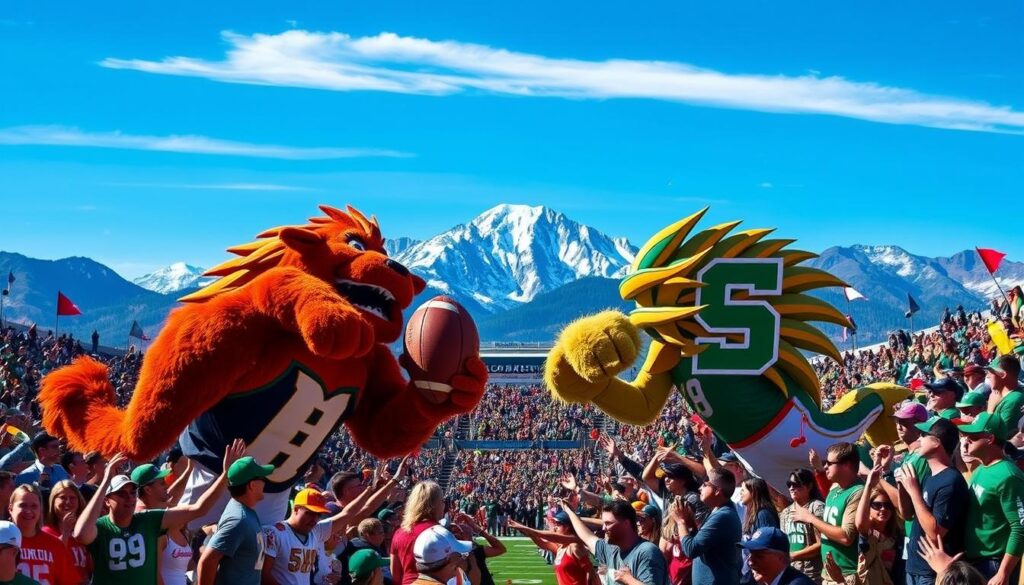Rivalries are the heart of college sports, and none shine brighter than the Colorado vs. CO State showdown. Known as the Rocky Mountain Showdown, this annual battle between the University of Colorado Buffaloes and Colorado State University Rams has enthralled fans for over a century. Each team fights for bragging rights and conference dominance. But does the music played during these games reveal the true essence of this historic rivalry? Let’s explore how music fuels the competitive spirit between these two Colorado giants.
Key Takeaways
- The Colorado vs. CO State rivalry has a rich history dating back to 1893, making it one of the oldest in-state college football matchups.
- The outcome of the Rocky Mountain Showdown can have significant implications for the teams’ standings in the Mountain West Conference and their national rankings.
- Passionate fans from both sides come together to witness the fierce competition and determine the bragging rights between these two Colorado-based powerhouses.
- Music has the power to ignite the competitive spirit and emotional investment of fans during these high-stakes encounters.
- The role of music in political campaigns and its influence on voter engagement is a topic worth exploring in the context of this rivalry.
The Music of Political Campaigns
Music is a crucial element in modern presidential campaigns, acting as an emotional trigger to motivate party supporters and sway undecided voters. In close presidential races, music can significantly influence outcomes. This is because most voters have already decided, leaving the race a statistical tie.
Political music stirs passion and emotion, with iconic tunes featured in presidential contests since George Washington and Thomas Jefferson’s times. It can turn mundane events, like the state-by-state roll call at political conventions, into lively dance parties that spread like wildfire.
Music as an Emotional Hook in Presidential Races
The musical choices of candidates convey strategic messages about their beliefs and appeal to various voter groups. Music is a potent tool in presidential campaigns, stirring emotions and forging connections with voters on a profound level.
The Role of Music in Conventions and Rallies
- Music can transform dull events at political conventions into dynamic, viral spectacles.
- Campaign music fuels excitement and fervor at presidential rallies.
- The musical selections of candidates convey strategic messages about their ideology and appeal to different voter groups.
| Candidate | Campaign Music | Demographic Appeal |
|---|---|---|
| Kamala Harris | Beyoncé’s “Freedom” | African American voters |
| Donald Trump | Lee Greenwood’s “God Bless the U.S.A.” | Patriotic, conservative voters |
“Music can be a powerful tool in presidential campaigns, evoking emotions and connecting with voters on a deeper level.”
Taylor Swift’s Endorsement of Kamala Harris
The endorsement of Kamala Harris by pop superstar Taylor Swift during the 2024 presidential campaign was a significant headline. Swift’s massive social media following and broad appeal across the ideological spectrum made her endorsement of the Democratic candidate particularly impactful. This was especially true for younger voters, who are more tightly contested in recent election cycles.
Swift’s endorsement highlighted the role that celebrity figures and their musical influence can play in shaping the political landscape. It showed how they can mobilize key voter demographics. The youth vote has become an increasingly important battleground, and Swift’s ability to connect with this demographic proved invaluable for the Harris campaign.
However, Swift’s endorsement also underscored the partisan divide that often characterizes contemporary American politics. While her support resonated strongly with Democratic voters, it was viewed with skepticism by some Republican supporters. They saw it as a blatant attempt to sway the youth vote in favor of the Democratic candidate.
Nonetheless, the celebrity endorsement of Kamala Harris by Taylor Swift served as a powerful reminder of the influential role that music and popular culture can play in the political process. As the 2024 election cycle unfolded, the interplay between music, celebrity, and politics continued to shape the narrative and capture the attention of the electorate.
The Battle for Younger Voters through Music
In the ever-evolving landscape of political campaigns, savvy candidates have recognized the increasing significance of engaging younger voters. This demographic is crucial and tightly contested. Music and social media influencers have emerged as powerful tools in this endeavor. British singer Charli XCX’s “Kamala IS brat” endorsement of the Democratic candidate is a prime example.
Charli XCX’s endorsement leveraged the popular “brat summer” trend on social media. It aimed to connect with the youth vote and mobilize millennial and Gen Z supporters. While some influencers critiqued the perceived politicization of the trend, it demonstrated the campaigns’ efforts to harness popular music and social media stars. This is to reach the youth vote, a key voting bloc in recent elections.
Charli XCX’s “Kamala IS brat” Endorsement
The Charli XCX endorsement was an early example of the growing trend of music and politics intertwining. Campaigns seek to capitalize on the social media influence of popular artists to sway millennial voters and partisan divide. By aligning themselves with youth-oriented cultural phenomena, campaigns hope to foster a sense of authenticity and relatability with younger audiences. This ultimately drives political endorsements and social media influence.
As the battle for the youth vote intensifies, the strategic use of music and social media influencers will likely continue to play a significant role. Campaigns will continue to vie to connect with the next generation of engaged, tech-savvy citizens.
colorado vs co state: Rivalry Fueled by Music
The rivalry between Colorado and Colorado State goes beyond the football field, with music being a key factor. The Rocky Mountain Showdown is more than a game; it’s a cultural event. It brings together fans from both sides, showcasing their school pride through music.
The musical aspect of the rivalry intensifies the fan’s emotional investment. It raises the stakes of this long-standing clash between the Buffaloes and the Rams. From marching band performances to student chants, music is a vital part of the colorado vs colorado state rivalry. It enriches the sports culture and fan engagement in this college football rivalry.
Music rivalry between Colorado and Colorado State extends beyond the stadium. Fans engage in friendly competitions on social media and at events before the game. This musical exchange enhances the sense of in-state rivalry and the pride each side has in their institution and athletics.
| Colorado Buffaloes | Colorado State Rams |
|---|---|
| Alma Mater: “Glory Colorado” | Alma Mater: “Fight, Colorado State” |
| Fight Song: “Fight, CU” | Fight Song: “Colorado State Fight Song” |
| Marching Band: “Marching Buffaloes” | Marching Band: “Colorado State Marching Band” |
The musical rivalry between Colorado and Colorado State showcases the deep passion and sports culture between these institutions. As college football rivalries continue to engage fans, the musical aspect of the colorado vs colorado state showdown remains crucial. It adds excitement and school pride to this enduring in-state competition.

The Significance of Popular Music in Political Campaigns
The strategic use of popular music in political campaigns has become increasingly crucial. Music has the power to inspire and mobilize a campaign’s party base while also potentially appealing to undecided voters. By carefully selecting musical acts and songs, campaigns can send powerful messages about their ideology and connect with specific voter demographics, particularly younger audiences.
Inspiring Party Bases and Undecided Voters
Music has the ability to transform typically tedious campaign events, such as convention roll calls, into energetic and viral moments that capture public attention. The emotional impact of music can generate passion and enthusiasm, making it a valuable tool for campaigns in close races where inspiring the base and swaying undecided voters can make the difference.
As political music becomes more integrated into campaign strategy, campaigns are leveraging its potential to drive voter engagement and party base mobilization. The strategic use of music can also help campaigns reach and resonate with undecided voters, who may be more receptive to the emotional appeals that music can provide.
“Music has the power to transform typically tedious campaign events, such as convention roll calls, into energetic and viral moments that capture public attention.”
The significance of popular music in political campaigns cannot be overstated. By harnessing the emotional and cultural influence of music, campaigns can create compelling narratives, energize their supporters, and potentially sway those who remain undecided. As the role of political music continues to evolve, it will undoubtedly play an increasingly crucial part in shaping the outcome of future campaign strategies and voter engagement efforts.
Republican vs Democratic Playlists and Endorsements
The 2024 presidential election saw stark contrasts in the musical selections and endorsements of the Republican and Democratic campaigns. The republican campaign music included classic rock anthems and patriotic hymns, with artists like Kid Rock and Lee Greenwood. These choices highlighted traditional masculinity and American nationalism. On the other hand, the democratic campaign music featured hits by artists of color and women, such as Chappell Roan’s “Femininomenon.” This music conveyed a message of inclusivity and gender fluidity.
The campaigns leveraged music as a strategic tool to engage with their bases and undecided voters. This highlighted the partisan divide in the musical endorsements landscape of American politics. The musical selections of each party reflected their distinct values and priorities. They also served as a powerful means of mobilizing their campaign strategy.
| Republican Playlist | Democratic Playlist |
|---|---|
|
|
The musical endorsements of the two parties showed their distinct approaches to appealing to their base and undecided voters. The Republican playlist emphasized traditional American values and masculine imagery. In contrast, the Democratic playlist offered a more diverse and inclusive representation of the electorate.
This contrast in musical choices reflected the fundamental differences between the parties. It also served as a campaign strategy to mobilize supporters and sway the partisan divide in the electorate.
Reclaiming Patriotism through Music
In a bold move, Kamala Harris has taken back political patriotism for the Democratic Party. She chose Beyoncé’s anthem “Freedom” as her campaign theme song. This move challenges the Republicans’ long-held claim on patriotic symbols and tunes. Harris’s choice of this song connects her to Beyoncé’s message of determination and the fight for freedom.
The song’s energetic drumbeat and lyrics about breaking chains resonate with Harris’s image. She is seen as a tough, independent woman of color. By using this music and patriotism, Harris aims to challenge the Republican Party’s grip on American democratic party patriotism. She presents the Democratic vision as equally, if not more, in line with national values.
Kamala Harris’ Use of Beyoncé’s “Freedom”
Beyoncé’s “Freedom” is a powerful anthem for the Beyoncé freedom movement. Its lyrics speak of breaking free from oppression and embracing self-determination. Harris’s choice of this song as her campaign theme is strategic. It taps into the Kamala Harris campaign sentiment, positioning her as a champion of the people.
“Freedom” is not just a song, it’s a call to action. Kamala Harris understands the power of music to inspire and unite. By embracing Beyoncé’s powerful message, she is reclaiming the mantle of patriotism for the Democratic Party.
The Israeli-Palestinian Conflict and the Role of Citizen Activism
The israeli-palestinian conflict has ignited a global wave of citizen activism. Millions worldwide have signed petitions, participated in demonstrations, and practiced civil disobedience. They urge the U.S. to cease financial, military, and political backing for Israel. This stance is backed by the united nations and the International Court of Justice, who see Israel’s actions as violating international law.
Calls for Ceasefire and Diplomatic Resolution
As a member of Veterans For Peace and Psychologists for Social Responsibility, Moji Agha advocates for a ceasefire. He demands the U.S. stop arming Israel, restore humanitarian aid to Gaza, and support the United Nations Relief and Works Agency for Palestine Refugees. This is crucial to address the humanitarian crisis in the region.
“The world cannot stand idly by while innocent lives are lost and fundamental human rights are violated. We must act now to end the cycle of violence and work towards a just, sustainable, and peaceful resolution to this conflict.”

The israeli-palestinian conflict has seen a rise in violence and human rights abuses in recent years. Activists globally are pushing for immediate action to safeguard civilians. They seek a diplomatic resolution to this enduring dispute.
Removing Donald Trump from Public Life
The United States is facing a critical period following the Donald Trump presidency. Many argue that to restore normal politics, Trump must be removed from public life. His “volcanic, incoherent, fact-free bombast” has created a fog that hinders constructive political conflict and future turbulence.
Removing Trump is seen as essential for the country’s progress. His polarizing presence blocks meaningful political discourse and finding common ground on critical issues. This makes him a major hurdle to the nation’s ability to address its challenges.
To overcome the divisive politics, experts advocate for marginalizing Trump’s influence. This could involve legal actions, media scrutiny, and public campaigns to discredit his rhetoric. The goal is to restore democratic institutions’ credibility.
By removing Trump, the United States can rebuild its political foundations. This will require a bipartisan effort to reject divisive politics. Only then can the nation embrace constructive conflict and progress.
“The restoration of normal politics in the United States will require the removal of former President Donald Trump from public life.”
Rekindling Constructive Political Conflict
As the United States moves to remove former President Donald Trump from public life, the goal is to revive normal politics. This involves reigniting a constructive political conflict. Such a clash of ideas is vital for the nation to face upcoming challenges and turmoil effectively.
The authors stress the importance of an engaged and organized citizenry in this endeavor. An active populace is key to a democracy’s health and the fulfillment of its democratic principles. By nurturing this political conflict, citizens can keep the political dialogue lively, varied, and attuned to the populace’s needs.
“Constructive political conflict is a necessary precondition for the United States to effectively address its challenges and uphold democratic principles.”
This political conflict should not be viewed as a destabilizing force but as a means to fortify the political system. Through intense debates, citizens can ensure their elected officials are accountable, challenge the current order, and advocate for significant reforms.
Following the Trump era, this political conflict offers a chance to revitalize citizen engagement. It ensures the United States remains a dynamic and enduring democracy.

| Aspect | Significance |
|---|---|
| Political Conflict | Necessary for addressing challenges and upholding democratic principles |
| Citizen Engagement | Essential for the healthy functioning of a democracy |
| Normal Politics | Crucial for restoring a vibrant and responsive political discourse |
The Importance of Music in Democracy
The strength of a democracy hinges on citizens exercising their power through voting. If music and democracy can boost voter turnout, it could lead to more trustworthy election results. Music’s power to evoke passion and enthusiasm could increase voter engagement and citizen participation. This is crucial for a democratic system to function properly.
Music has always been a key player in political movements, mobilizing and inspiring people. From civil rights anthems to campaign songs, it connects with us on an emotional level, bridging partisan gaps. By leveraging this emotional connection, music can be a vital tool for boosting political legitimacy and democratic participation.
The role of music in politics is significant for American democracy’s health. As the country faces voter apathy and polarization, music’s strategic use could re-energize the electorate. This could strengthen our democratic system’s foundations.
“Music has the power to bring people together, to inspire action, and to amplify the voices of the people. In a time of political division, it can serve as a unifying force that transcends partisan lines and reminds us of our shared values and aspirations as citizens.”
| Potential Benefits of Music in Democracy | Potential Challenges |
|---|---|
|
|
Conclusion
The Colorado vs. CO State rivalry, known as the Rocky Mountain Showdown, is a longstanding and intense in-state college football clash. It extends beyond the gridiron into the realms of music and culture. This rivalry, fueled by passionate fan bases and their musical displays of support, is emblematic of the broader role that music plays in the political landscape of the United States.
From its use as an emotional hook in presidential campaigns to its ability to inspire party bases and engage younger voters, music has become an increasingly significant factor in the country’s democratic processes. As the nation navigates complex political challenges, the power of music to mobilize citizens and strengthen the foundations of democracy remains a crucial consideration for the future of American politics.
The interplay between college football rivalries, political campaigns, and the influence of music and politics underscores the intricate tapestry of voter engagement and the preservation of democratic principles. The enduring legacy of the Rocky Mountain Showdown serves as a microcosm of these larger themes. It reminds us of the transformative potential of music in shaping the course of our nation’s political discourse.
FAQ
What is the Rocky Mountain Showdown?
The Rocky Mountain Showdown is a fierce college football rivalry between the University of Colorado Buffaloes and Colorado State University Rams. It’s an annual event that draws passionate fans from both sides. They gather to witness the intense competition for bragging rights between these two Colorado powerhouses.
How does music play a role in modern political campaigns?
Music is crucial in modern political campaigns. It serves as an emotional hook to inspire party bases and engage undecided voters. By transforming campaign events into energetic, viral moments, music captures public attention.
How did Taylor Swift’s endorsement of Kamala Harris impact the 2024 presidential campaign?
Taylor Swift’s endorsement of Kamala Harris was a major highlight in the 2024 presidential campaign. Swift’s massive social media following and broad appeal made her support significant. It was especially impactful in attracting younger voters.
How did Charli XCX’s “Kamala IS brat” endorsement demonstrate the campaigns’ efforts to engage younger voters?
Charli XCX’s endorsement of Kamala Harris showcased campaigns’ efforts to engage younger voters. By leveraging popular music and social media stars, campaigns aim to mobilize this crucial voting bloc.
How does the Colorado vs CO State rivalry extend beyond the football field?
The rivalry between Colorado and CO State goes beyond football. Music plays a significant role in intensifying the competition between these in-state college powerhouses. The Rocky Mountain Showdown is a cultural event that brings fans together, showcasing their school pride through musical displays.
How has the use of popular music in political campaigns become increasingly significant?
The role of popular music in political campaigns has grown. It has the power to inspire and mobilize party bases while appealing to undecided voters. Music can transform campaign events into energetic, viral moments that capture public attention.
How did the Republican and Democratic playlists and endorsements in the 2024 presidential election reflect partisan divides?
The Republican playlist featured classic rock anthems and patriotic hymns, emphasizing traditional masculinity and American nationalism. In contrast, the Democratic playlist included youth-oriented hits by artists of color and women. This sent a message of inclusivity and gender fluidity.
How did Kamala Harris’ use of Beyoncé’s “Freedom” as her campaign theme song challenge the Republican Party’s monopoly on patriotism?
Kamala Harris’ use of Beyoncé’s “Freedom” as her campaign theme song was a strategic move. It aimed to reclaim patriotism for the Democratic Party. By featuring this patriotic song, Harris challenged the Republican Party’s monopoly on American patriotism.
How can the removal of Donald Trump from public life and the rekindling of constructive political conflict help restore normal politics in the United States?
Restoring normal politics in the United States requires Donald Trump’s removal from public life. It also needs the rekindling of constructive political conflict. This conflict is seen as essential for the country to effectively navigate upcoming challenges.
How can music contribute to the legitimate functioning of a democratic system?
Music can contribute to a democratic system by increasing voter engagement and participation. Its ability to generate passion, emotion, and enthusiasm has the potential to boost voter turnout. This is crucial for the healthy functioning of a democracy.
